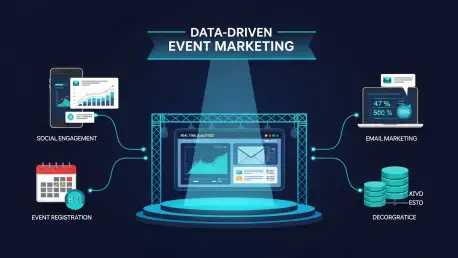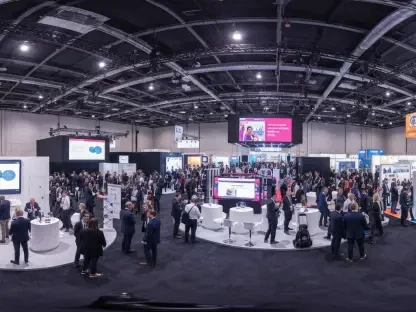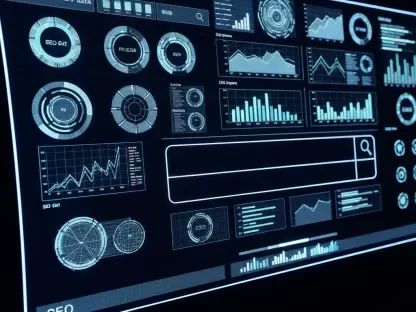In today’s fast-paced digital landscape, where virtual and hybrid events have become the norm, event marketers face mounting pressure to deliver measurable results while managing tight budgets, making the strategic use of data more critical than ever. Imagine hosting a global conference with thousands of attendees, only to realize post-event that engagement was low and leads were scarce, leaving stakeholders questioning the investment. This scenario underscores a critical challenge: how can marketers ensure that every dollar spent on events translates into tangible value? With the cost of in-person events soaring—projected to rise by 4.3% per attendee per day to $169 this year according to industry forecasts—leveraging data has emerged as the linchpin for success. This guide aims to equip marketers with actionable strategies to maximize return on investment (ROI) by harnessing data at every stage of the event lifecycle. From planning to post-event follow-ups, the insights provided here will help transform events into strategic assets that drive engagement, cut costs, and build lasting customer relationships.
Why Data is the Key to Event Success in a Digital World
The shift to digital platforms has redefined how events are conceptualized and executed, placing data at the forefront of achieving impactful outcomes. As virtual and hybrid formats gain prominence, marketers must navigate a landscape where audience expectations are higher than ever, demanding personalized and seamless experiences. Data offers a way to meet these demands by providing insights into attendee behavior, preferences, and pain points, enabling tailored approaches that resonate deeply.
Financial pressures further amplify the importance of a data-driven mindset. With budgets under scrutiny, justifying event spending requires clear, measurable results that demonstrate value to stakeholders. Data serves as the bridge between expenditure and outcome, offering concrete metrics to showcase success, whether through lead generation numbers or engagement rates.
Moreover, the ability to leverage data before, during, and after events creates a comprehensive framework for optimization. Pre-event analytics can shape targeted marketing campaigns, real-time data during events can enhance live experiences, and post-event insights can extend impact through strategic follow-ups. This holistic approach ensures that every phase contributes to maximizing ROI and fostering enduring connections with attendees.
The Shift to Virtual and Hybrid Events: A Response to Economic and Digital Trends
Rising costs associated with traditional in-person events have pushed marketers to explore more sustainable alternatives. Expenses such as venue rentals, travel, and catering continue to climb, with industry reports indicating a steady increase of 4.3% per attendee per day, reaching $169 as of this year. Virtual and hybrid formats present a cost-effective solution, eliminating many logistical burdens while maintaining the ability to deliver impactful experiences.
Beyond economics, digital transformation has reshaped audience expectations, with participants now favoring accessible, on-demand content over travel-heavy commitments. These formats cater to a global audience, breaking geographical barriers and allowing for broader reach without the hefty price tag. The scalability of digital events also means that marketers can adjust scope based on demand, optimizing resources efficiently.
Additionally, virtual and hybrid events generate a wealth of data that in-person setups often lack. From registration details to real-time engagement metrics, these platforms provide granular insights that empower marketers to make informed decisions. This data-rich environment positions digital events as strategic tools for those aiming to balance budget constraints with the need for measurable impact.
Harnessing Data at Every Stage of the Event Lifecycle
Pre-Event Planning: Setting the Foundation with Clear KPIs (Step 1)
The journey to maximizing event ROI begins long before the event itself, with the establishment of key performance indicators (KPIs) that align with overarching business goals. Whether the aim is to generate a specific number of leads or elevate brand awareness, defining these metrics early ensures that every decision—from content creation to marketing—serves a purpose. This clarity helps allocate resources effectively, avoiding wasted effort on elements that do not contribute to the desired outcome.
Defining Measurable Objectives for Targeted Outcomes
Setting precise, measurable objectives is critical to guiding event planning. For instance, a goal to capture 500 qualified leads can dictate the design of registration forms, the focus of promotional campaigns, and even the selection of speakers or topics. Such specificity ensures that each component of the event is strategically crafted to drive results, providing a roadmap for success that stakeholders can rally behind.
Using Historical Data to Predict Attendance and Engagement
Analyzing data from past events offers a powerful tool for anticipating attendee behavior and refining strategies. Metrics such as registration rates, session attendance, and interaction levels can reveal patterns that inform expectations for the upcoming event. Tailoring content or outreach based on these insights—perhaps focusing on topics that historically drew larger crowds—can significantly boost participation and engagement, setting a strong foundation for ROI.
Real-Time Execution: Adapting with Live Insights (Step 2)
Once the event is underway, the ability to collect and act on real-time data becomes a game-changer for enhancing attendee experiences. Monitoring metrics like session attendance, engagement through polls, and drop-off points allows marketers to identify what resonates and what falls flat. This immediate feedback loop empowers quick adjustments that can salvage underperforming elements and amplify successful ones.
Monitoring Key Metrics for On-the-Fly Adjustments
Tracking specific indicators during the event, such as live polling responses or chat activity, provides a window into audience sentiment. A sudden dip in participation during a session might signal content fatigue, prompting a shift to a more interactive format like a Q&A. These metrics act as a pulse check, ensuring that the event remains dynamic and responsive to attendee needs, thereby maximizing engagement.
Enhancing Engagement Through Dynamic Content Tweaks
The flexibility to adapt content mid-event is a hallmark of digital platforms, offering opportunities to pivot based on live data. For example, if analytics show high interest in a particular topic, extending related sessions or adding impromptu discussions can keep momentum high. Conversely, addressing areas of low engagement by introducing networking breaks or gamification elements can rekindle interest, ensuring that attendees remain connected throughout.
Post-Event Analysis: Extending Impact with Feedback and Follow-Ups (Step 3)
The value of an event does not end when it concludes; post-event data analysis plays a vital role in sustaining ROI over the long term. Gathering feedback through surveys and analyzing participation metrics offers a clear picture of successes and areas for improvement. This step ensures that lessons learned are applied to future initiatives, continuously refining the approach to event planning.
Gathering Attendee Insights via Surveys and Polls
Post-event surveys and polls serve as invaluable tools for understanding attendee experiences. Questions about content relevance, session quality, or technical issues can uncover actionable insights that shape future events. High response rates to these feedback mechanisms often indicate a still-engaged audience, providing a wealth of qualitative data to complement quantitative metrics.
Repurposing Content for Long-Term Value
Transforming event content into reusable assets extends its lifespan and reach. Recordings of popular sessions can be repurposed into blog posts, social media snippets, or internal training materials, keeping the conversation alive well after the event. This strategy not only maximizes the initial investment but also reinforces brand messaging across multiple channels, reaching new audiences.
Personalizing Follow-Ups to Build Lasting Connections
Using attendee data to craft personalized follow-up communications fosters loyalty and deepens relationships. Tailored emails addressing specific interests—perhaps referencing a session an individual attended—demonstrate attentiveness and value. This customized approach turns a one-time interaction into an ongoing dialogue, enhancing the likelihood of future engagement and conversions.
Core Strategies for Data-Driven Event ROI: A Quick Recap
- Define clear KPIs to align event goals with business objectives, ensuring every action supports measurable outcomes.
- Use real-time data to adapt content and engagement tactics during events, responding swiftly to audience needs.
- Leverage post-event insights and personalized follow-ups to extend impact and build enduring relationships with attendees.
The Broader Impact: Data’s Role in Shaping the Future of Events
The strategies outlined reflect a broader trend of digital transformation within the events industry, where technology continues to redefine engagement. Data-driven approaches address immediate challenges like budget constraints and ROI justification while positioning marketers to capitalize on emerging tools such as advanced analytics or AI-driven personalization. These innovations promise even greater precision in understanding and catering to audience needs.
However, this evolution is not without hurdles. Concerns around data privacy remain a significant consideration, requiring careful handling of attendee information to maintain trust. Additionally, barriers to technology adoption, particularly for smaller organizations, can slow the integration of sophisticated data tools, highlighting the need for accessible solutions.
Looking ahead, the role of data in events will only grow, shaping formats and experiences in ways that prioritize individualization. As personalization becomes a cornerstone of marketing, events must evolve to deliver bespoke interactions that stand out in a crowded digital space. Embracing data now prepares marketers for this future, ensuring they remain competitive amid rapid industry shifts.
Final Thoughts: Transforming Events into Strategic Assets with Data
Reflecting on the journey through the event lifecycle, it became evident that data had been the cornerstone of turning virtual and hybrid events into powerful drivers of ROI. Each step, from setting KPIs to adapting in real time and personalizing follow-ups, demonstrated how actionable insights could elevate outcomes. The impact went beyond immediate metrics, fostering connections that promised long-term value.
Marketers who embraced these strategies found themselves better equipped to navigate financial pressures and evolving expectations. The next step involves exploring advanced data tools or experimenting with AI to uncover deeper attendee insights. By continuing to prioritize data, future events can achieve even greater precision in engagement and efficiency.
Additionally, building a culture of continuous learning from each event’s data proved essential. Sharing post-event analyses across teams ensured that successes were replicated and missteps avoided. This commitment to iterative improvement transformed events from one-off expenses into enduring strategic assets, paving the way for sustained growth in a digital-first era.









